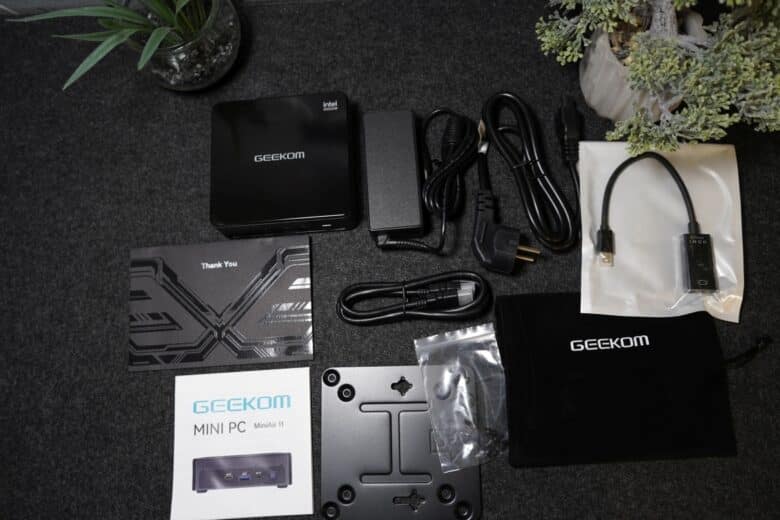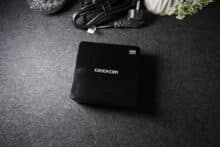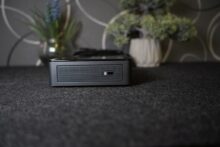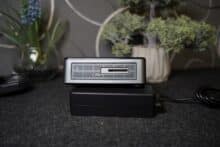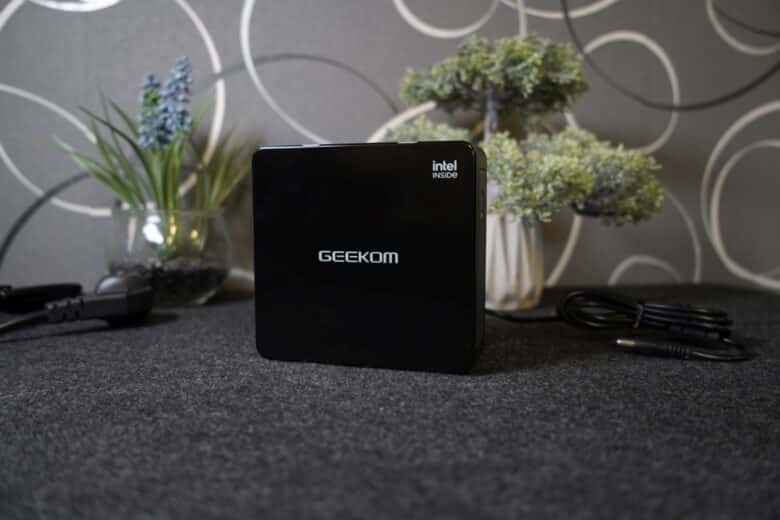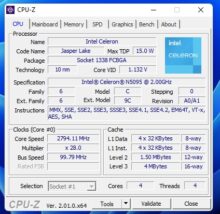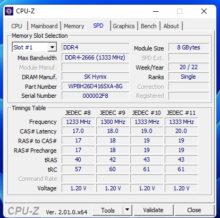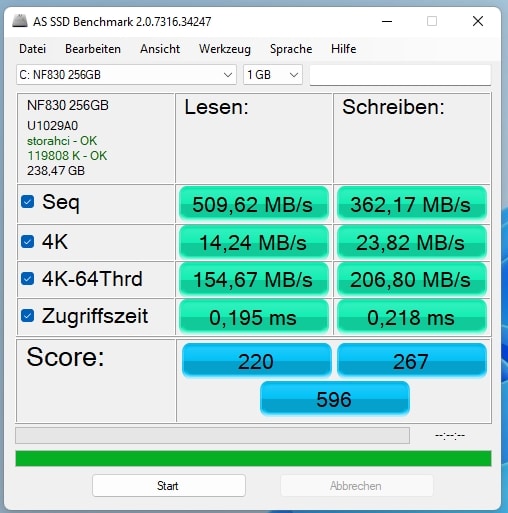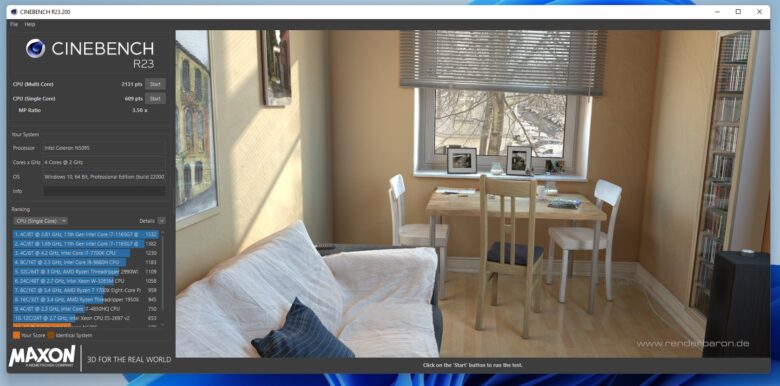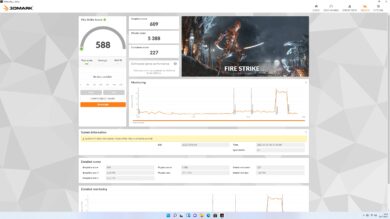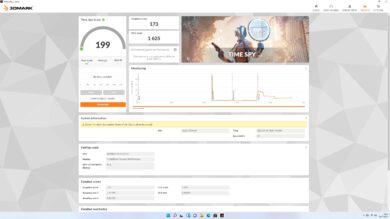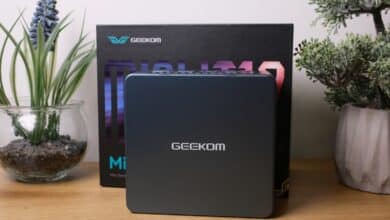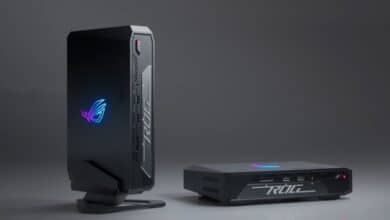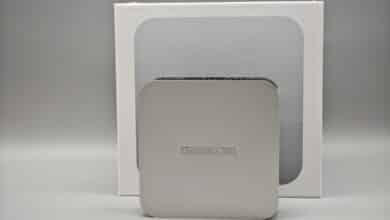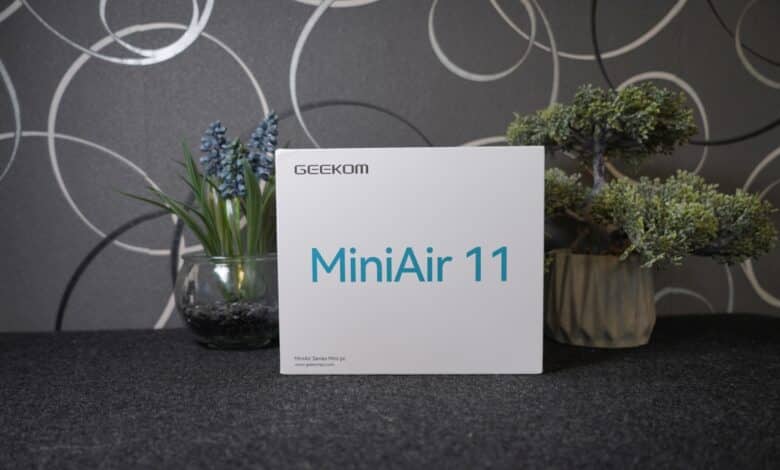
“Square, practical, small” is not the official slogan of the mini-PC (probably because it already exists in a similar form), but it would still be appropriate. We took a look at the new computing dwarf from GEEKOM, which even makes Apple’s MacMini look gigantic. Our GEEKOM MiniAir 11 review clarifies whether the small cube has great potential.
Technical data
| Processor | Quad-core Intel Celeron N5095 up to 2.9 GHz |
| Graphics performance | Integrated UHD graphics |
| Dimensions (L x D x H) | 115 mm x 110 mm x 40 mm |
| Weight | 498 grams |
| Storage | 256GB SSD M.2 2280 |
| Memory | 8GB DDR4 |
| Video | HDMI and mini DisplayPort up to 4K resolution; |
| Operating system | Windows 11 Pro |
| Connectivity | Wi-Fi 5, Gigabit Ethernet, Bluetooth 4.2 |
| Connectors | 1 x HDMI 1.4, 1 x Mini DisplayPort, 2 x USB 3.2 Gen 1, 1 x USB 3.2 Gen 2, 2 x USB-C ports (data only), 1 x SD card reader (USB2.0) , 1 x 3m5-mm jack, 1 x RJ45 Gigabit Ethernet |
| Price | € 199.99 * |

GEEKOM MiniAir 11 review: the scope of delivery
- All cables included
- Transport bag and accessories for wall mounting included
The GEEKOM MiniAir 11 marks the most affordable mini PC in the manufacturer’s portfolio and relies on… well, let’s say familiar and distinctive terms from another manufacturer for its naming.
It comes in a square, white cardboard box, which is packed to the brim despite its manageable size. Besides the actual mini-PC, the manufacturer includes a whole host of accessories.
There is, of course, the obligatory power supply including power cable, a manual and even a thank-you card for the purchase. In addition, there is a cloth bag for safe transport and a plate with screws for potential wall mounting. An HDMI cable is also included in the box for the picture output, which turns out to be quite manageable with a length of one meter. But corresponding cables are available in almost everyone’s home anyway.
Rounding out the package is an HDMI to Mini DisplayPort adapter for connecting a second monitor, if that’s what you want.
Design and finish
- Extremely compact mini PC
- Air vents on three sides
The GEEKOM MiniAir 11 presents itself as a really compact box kept in black. With dimensions of 11.5 cm x 11.0 cm x 4.0 cm (width x depth x height) including rubberized feet, the MiniAir 11 certainly lives up to its name and turns out even smaller than the Aerofara Mini PC, which we tested in March.
In addition, the manufacturer relies on a simple look. Only the upper side is kept in glossy black and is centrally adorned by the GEEKOM logo. The inscription “Intel Inside” is found on the upper right.
On the bottom, you’ll find the serial number and some information, two screw threads for mounting on a wall or monitor, as well as the four rubberized feet, which you can also unscrew if desired. You can also access the inside of the Mini-PC by loosening the four screws.
Air outlets are found on both sides, interrupted by an SD card slot on the left and a Kensington Lock connector on the right. The third and largest air vent is found in the upper third on the back of the mini-PC.
The sides are also kept in a matte silver tone, whereas the front panel is even darker. All in all, the design looks well thought-out, tidy and pleasantly simple.
What ports does the GEEKOM MiniAir 11 offer?
This is also evident in the selection of ports, which GEEKOM sensibly distributes across the front and back. I find it absolutely amazing what a wide selection they cram into such a compact case here.
On the front is of course the (appropriately also square) power button, which you can use to turn on the MiniAir 11. In addition, however, there are the following ports:
- 1x USB Type-C (USB 3.2 Gen 1)
- 1x USB Type-A (USB 3.2 Gen 2)
- 1x 3.5mm jack combo port
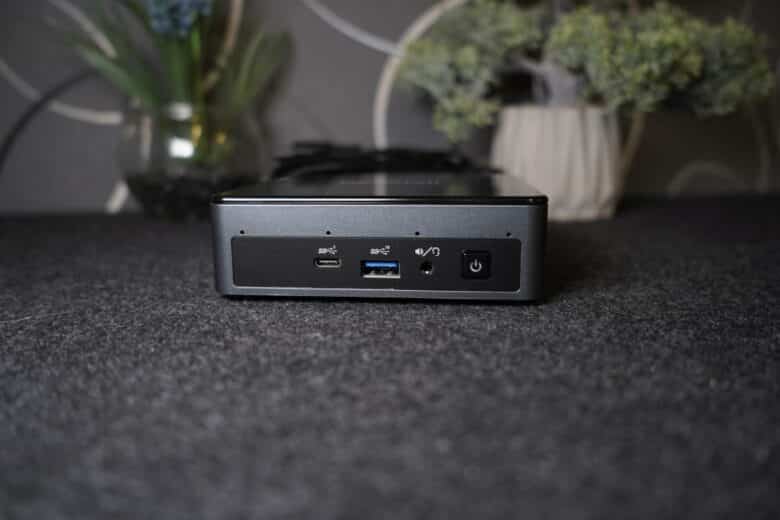
On the other hand, you’ll find most of the ports on the back. The following ports are added here once again:
- 1x power connector
- 1x Mini DisplayPort
- 1x Ethernet LAN
- 2x USB Type-A (USB 3.2 Gen 1)
- 1x USB Type-C (USB 3.2 Gen 2)
- 1x HDMI (1.4)

Here, the GEEKOM MiniAir 11 is thus much more broadly positioned than, for example, the more expensive Aerofara Aero 5 Pro or Apple’s current MacMini with M1 chip. However, it has to be considered that the USB-C ports can only be used for data traffic. Unfortunately, image rendering is not possible via it.
How good is the workmanship?
- High-quality and robust workmanship
- Surface susceptible to dust and fingerprints
I also really like the build quality of the MiniAir 11, which is largely made of metal despite the low price and feels very robust. The comparatively high weight of 498 grams for the pure mini-PC also speaks for this.
Everything feels sturdy and high-quality, although the glossy surface is naturally likely to be a magnet for fingerprints and probably scratches as well.
Startup, volume, and heat generation
- Quick and straightforward setup
- Almost always nearly silent operation
- Very low heat generation
Once you’ve connected the GEEKOM MiniAir 11 to the power supply and monitor and connected your favorite peripherals, it’s time for setup. The manufacturer ships the mini PC with Windows 11 Pro, but also promises full compatibility with Linux, Android x86, Ubuntu, and FydeOS, if you prefer.
Of course, the start-up is also accompanied by the obligatory updates first. Time for a test of the volume. Here, the small box stays nice and quiet with around 30 decibels in idle mode. But even under full load, the volume is in a pleasant range with 40.4 measured decibels.
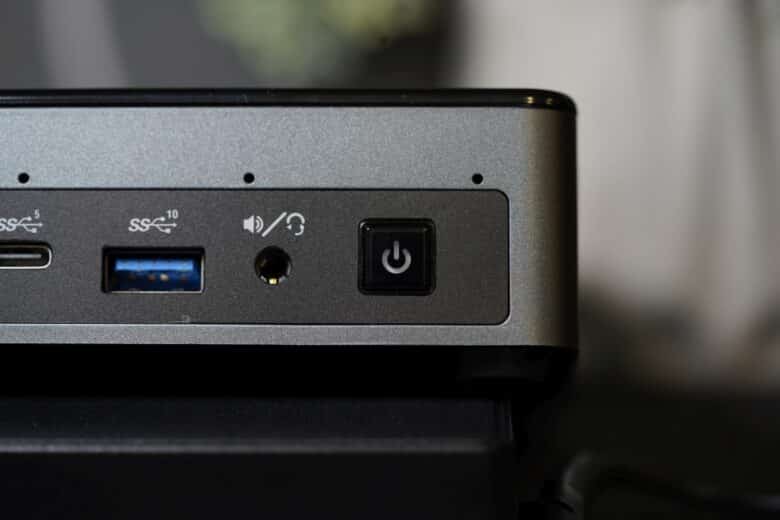
The heat development is similarly good. In fact, the built-in fan does a good job. Thus, the CPU gets a maximum of 65 degrees Celsius in the stress test, but quickly drops to around 54 °C in less demanding tasks.
On the outside, the mini-PC also only gets lukewarm and can still be touched without problems on all sides. Of course, a correspondingly warm exhaust air can be noticed especially at the largest fan outlet at the back, but it is not unpleasantly hot either. It is also astonishing that the GEEKOM MiniAir 11 only minimally lowers the CPU clock rates under permanent load.
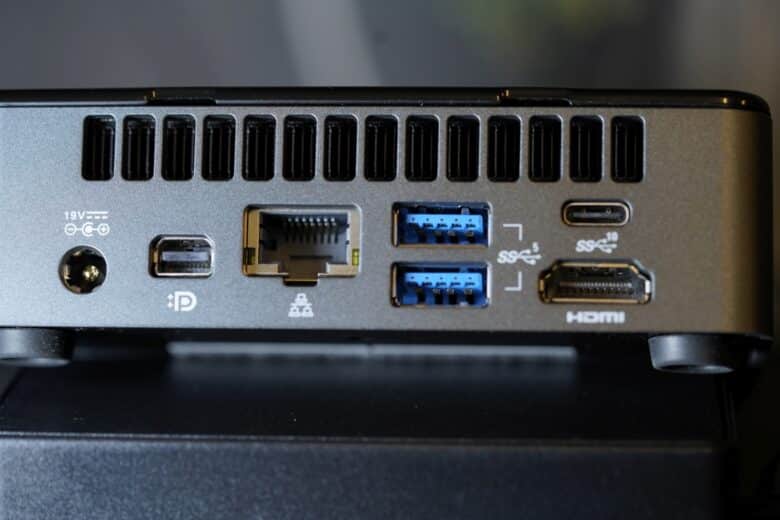
Practical test: How does the GEEKOM MiniAir 11 perform?
- Good performance in office mode
- SSD and RAM can be expanded without any problems
- Not rather suitable for gaming
Before we get to the practice, first the basics. GEEKOM clearly positions the MiniAir 11 as a business and office computer. Thus, the installed hardware is not designed for demanding gaming ambitions, but the performance is still quite sufficient for less demanding titles.
An Intel Celeron N5095 of the 11th generation (Jasper Lake) with a TDP of 15 watts is installed. It is supported by 8 GB of DDR4 working memory. The graphics are calculated internally via the integrated Intel UHD Graphics 605 graphics chip. Storage is on a 256 GB M.2 2280 SATA SSD.
Both the working memory and the system memory can be expanded if desired. The MiniAir 11 can hold a maximum of 32 GB RAM and a maximum of 1 TB SSD storage. The mini PC communicates wirelessly via Wi-Fi 5 and Bluetooth 4.2, but you can also connect to the network via Gigabit LAN.
In practice, the GEEKOM MiniAir 11 is very well suited for office and normal business tasks, which it performs quickly, reliably and quietly. The mini-PC does not make any mistakes when consuming 4K videos and working with Excel at the same time and completes all tasks without any problems.
I also find it practical that you can connect it to two 4K displays at the same time via HDMI and DisplayPort, for example to separate private and professional use in a multi-monitor setup or to combine them for more space.
Connecting Bluetooth devices like headphones, keyboards or the like also works reliably. The mini PC achieves the maximum possible speeds in WLAN mode as well as with a connected LAN cable.
What the Mini-PC cannot do, however, and I don’t mean at all, is gaming. We’ll come back to that in the benchmark tests in a moment. But if you have even minor gaming ambitions that go beyond browser games, this is not the right mini-PC for you.
I have to say that quite clearly. However, it is not intended by the manufacturer, but you should consider it in your purchase decision. A decent CPU with decent internal graphics is installed, which can handle 90% of all office tasks well. But not much more.
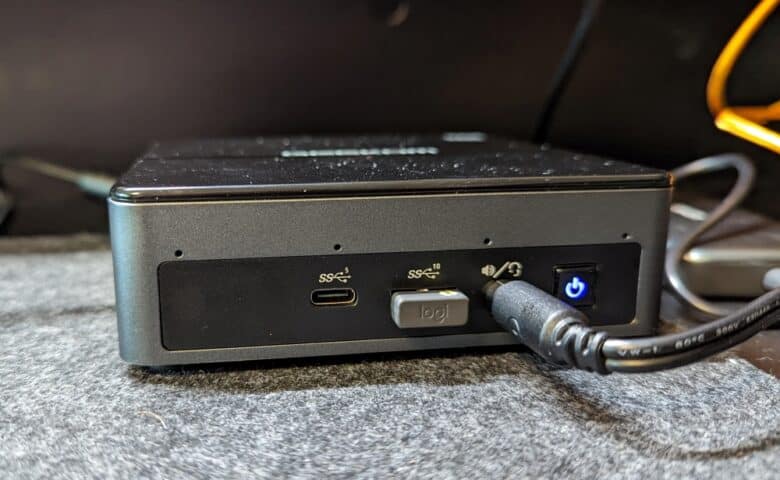
I consider 8 GB RAM to be tight nowadays – unless you have an Apple PC or notebook. This should also be considered in your decision, because the GEEKOM MiniAir 11 quickly reaches its limits, especially in quite demanding multitasking. So maybe you should go for the 16 GB model or upgrade it.
Benchmark tests
To measure the performance of the GEEKOM MiniAir 11, I subjected it to various benchmark tests. Among other things, the system performance of the CPU in the single and multi-core range was checked, as well as the speed of the installed SSD.
In PCMark10, for example, I took a look at how the Mini-PC holds up to various everyday tasks, and in the 3DMark test, the MiniAir 11 had to face medium gaming demands.
SSD test
First, the SSD of the GEEKOM MiniAir 11 is put to the test. Of the 256 GB, around 237 GB are effectively available for free use. The rest is used for the operating system. The benchmark tests CrystalDiskMark and AS SSD deliver relatively similar results.
With an overall score of 596, the storage is rather at the lower end and achieves around 510 MB/s in sequential read and 362 MB/s in sequential write. The reading performance is minimally above that of the Aerofara Mini-PC, but the writing performance is at a disadvantage.
This also shows that you can’t quite keep up even with current mid-range or budget SSDs. Especially since the access times for reading and writing turn out comparatively high. However, the offered performance is sufficient for everyday use.
System benchmark: Cinebench R23 and PCMark 10
And what about the everyday performance of the GEEKOM MiniAir 11? I took a detailed look at that in Cinebench R23 on the one hand, and in the all-round test PCMark 10 on the other. It is first noticeable that both tests take quite a bit of time, which already provides a first insight into the results.
In Cinebench R23, the mini-PC scores 609 points in the single-core and 2,131 points in the multi-core test, which is a decent result due to the four real cores. However, it is also clearly behind the Core i7-4850HQ or the Core i7-1165, which both have 8 threads available.
The installed Celeron N5095 from the year 2021 doesn’t offer that. It ultimately ranks in the good midfield of the low-priced CPUs and beats the similar Celeron N5105 in pure CPU performance.
The MiniAir 11 achieves a total of 2,306 points in the PCMark 10 test and thus also has to admit defeat to the Intel Pentium Silver N6005 processor, which is used in the Aerofara Aero 5 Pro, in all aspects. However, it costs almost twice as much as the GEEKOM Mini-PC, which of course always has to be seen in relation.
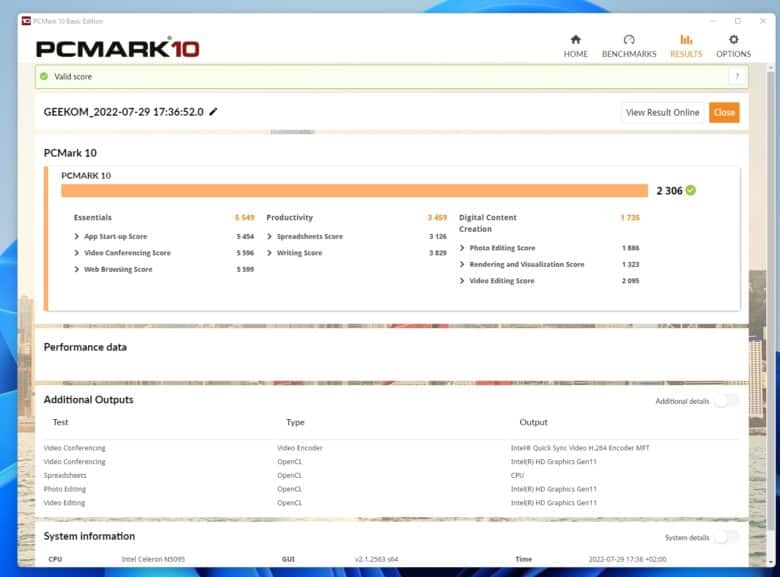
However, the model can keep up well especially in the essential tests and the spreadsheet benchmarks. This also shows where the core competence lies. Because it is precisely in these areas that the GEEKOM MiniAir 11 does a really good job and can both maintain constant performance and operate almost silently even under continuous load.
Gaming test: 3D Mark
Of course, we didn’t miss the chance to let the mini-PC loose on Fire Strike and Time Spy in the 3DMark benchmark test. Here it quickly becomes apparent that the MiniAir 11 is just not a gamer.
With framerates below the 5 FPS mark, you are not at the right address with gaming ambitions here. The manufacturer states that casual games like Minecraft, Sid Meier’s Civilization V and Dragon Age: Origins can be played smoothly on the mini-PC, but we think that is rather unlikely. Other solutions are more likely, which GEEKOM would of course also have up its sleeve.
GEEKOM MiniAir 11 review: Conclusion
I quite liked the GEEKOM MiniAir 11 in the test and was pleasantly surprised several times. I find the compact design really appealing. I also like the fact that the mini-PC is almost completely silent. Every now and then, the fan spins up very briefly, but then returns to quiet mode very quickly.
The compact computer also scores points with its enormous selection of ports, which makes even much more expensive rivals look old. Including two USB-C ports. That has rarity value.
As an inexpensive office machine, the MiniAir 11 does not make any major mistakes and performed all the tasks I presented it with without any problems. Only the somewhat low speed of the installed SSD is annoying, which is definitely noticeable when moving larger amounts of data. The system performance is absolutely sufficient for office requirements, although I would have liked to see 16 GB of working memory.
But you can upgrade that quite cheaply yourself, just like a faster SSD. If you’re looking for a compact and whisper-quiet work PC with plenty of ports, the GEEKOM MiniAir 11 is a good option in any case.
GEEKOM MiniAir 11
Design & workmanship
Features & Software
Performance
Value for money
88/100
Tiny mini-PC equipped with many ports, which delivers a convincing performance in office mode at a fair price and can be expanded.


